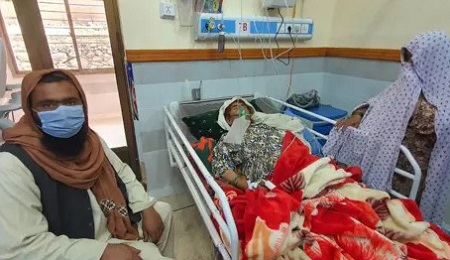BREAKING! Deadly Crimean-Congo Hemorrhagic Fever Outbreak in Afghanistan Kills 20 And Infects 265 Infected in Last Two Weeks!
Nikhil Prasad Fact checked by:Thailand Medical News Team Jul 01, 2024 9 months, 3 weeks, 4 days, 9 hours, 58 minutes ago
Medical News: Afghanistan is currently grappling with a severe outbreak of Crimean-Congo Hemorrhagic Fever (CCHF), a deadly viral disease that has claimed the lives of 20 individuals and infected 265 more in just the past two weeks. The situation is deteriorating rapidly as the number of cases continues to rise, overwhelming healthcare facilities and exposing significant gaps in the country's diagnostic capabilities.
 Deadly Crimean-Congo Hemorrhagic Fever Outbreak in Afghanistan Kills
Deadly Crimean-Congo Hemorrhagic Fever Outbreak in Afghanistan Kills
20 And Infects 265 Infected in Last Two Weeks!
Sharp Increase in Cases
Sharafat Zaman Amarkhail, spokesperson for the Ministry of Public Health, shared alarming statistics with Thailand
Medical News, "In June, we recorded 265 positive cases across the country, indicating that the number of cases has quadrupled compared to the previous month." This dramatic surge highlights the urgent need for effective containment measures and public awareness campaigns.
High-Risk Groups and Transmission
CCHF is primarily transmitted through bites from infected ticks or direct contact with the blood or tissues of infected animals or people. High-risk groups include farmers, butchers, and those who work in slaughterhouses. The virus can also spread between humans through bodily fluids. Medical experts emphasized the importance of adhering to health protocols: "When we care for a patient, all health protocols must be followed. Similarly, when we slaughter animals, health protocols must be observed because most of our patients are either butchers or have a family member with Congo fever."
Increasing Strain on Healthcare Facilities
Doctors at the infectious diseases hospital in Kabul have reported a significant increase in CCHF patients. One doctor noted, "A few days ago, our statistics significantly increased in our hospital because we had allocated more resources to Congo fever patients." Currently, forty people are hospitalized due to the disease, stretching the hospital's resources thin.
The CCHF Virus: An Overview
The Crimean-Congo Hemorrhagic Fever Virus (CCHFV) is a member of the genus Orthonairovirus, family Nairoviridae of RNA viruses. The virions are pleomorphic and measure 80-120 nanometers in diameter. Each virion contains three distinct RNA sequences that make up the viral genome. The virus's envelope is formed from a lipid bilayer and contains small projections. Viral entry into host cells is believed to be clathrin-mediated, with the cell surface protein nucleolin playing a role.
https://www.cdc.gov/crimean-congo-hemorrhagic/about/index.html
Understanding CCHF: Symptoms and Transmission
CCHF is caused by the Crimean-Congo Hemorrhagic Fever Virus (CCHFV). Symptoms typically appear within 2-7 days of infection and can includ
e fever, muscle pains, headache, vomiting, diarrhea, and bleeding into the skin. In severe cases, the disease can lead to liver failure and death. The virus is most commonly spread by tick bites or through contact with the blood, secretions, or other bodily fluids of infected persons or animals. Diagnosis can be confirmed through antibody detection, viral RNA, or viral proteins (antigens).
Clinical Manifestations and Outcomes
Following infection by a tick bite, the incubation period for CCHF is typically two to three days but can last up to nine days. Symptoms begin suddenly with fever, muscle aches, dizziness, neck pain, and sensitivity to light. As the illness progresses into the hemorrhagic phase, patients may experience severe bruising, nosebleeds, and uncontrolled bleeding. Other symptoms include a fast heart rate, enlarged lymph nodes, and rashes caused by bleeding into the skin.
In documented outbreaks, fatality rates in hospitalized patients have ranged from 9% to 70%, with death often occurring in the second week of illness. Patients who recover generally begin to improve around the ninth or tenth day after symptom onset. However, the long-term effects of CCHF infection are not well-studied, and recovery can be slow.
No Approved Treatment or Vaccine
Currently, there are no FDA- or WHO-approved treatments or vaccines for CCHF. Prevention focuses on avoiding tick bites, following safe practices in meat processing plants, and observing universal healthcare precautions. Treatment is primarily supportive, with the antiviral medication ribavirin sometimes used to help manage the disease.
Urgent Need for Action
The ongoing CCHF outbreak in Afghanistan underscores the urgent need for improved healthcare infrastructure, better diagnostic tools, and increased public awareness. As the country continues to battle this deadly virus, the international community must also step in to provide support and resources to help contain the outbreak and prevent further loss of life.
For the latest about the Crimean-Congo Hemorrhagic Fever Outbreak in Afghanistan, keep on logging to Thailand
Medical News.
Read Also:
https://www.thailandmedical.news/news/breaking-south-korea-reports-third-fatality-from-sfts-virus-in-2024-experts-warn-that-infections-rates-could-rise
https://www.thailandmedical.news/news/oropouche-virus-infects-74-in-cuba-a-new-threat-to-the-americas
https://www.thailandmedical.news/news/breaking-oropouche-virus-makes-a-resurgence-22-cases-in-bolivia-possibly-behind-rise-in-unexplained-fevers-and-platelet-dips-in-india
https://www.thailandmedical.news/news/oropouche-virus-infections-caused-by-mosquitoes-and-midges-rising-in-bolivia-peru-chile-brazil-and-elsewhere-in-americas
https://www.thailandmedical.news/news/breaking-oropouche-virus-makes-a-resurgence-22-cases-in-bolivia-possibly-behind-rise-in-unexplained-fevers-and-platelet-dips-in-india
